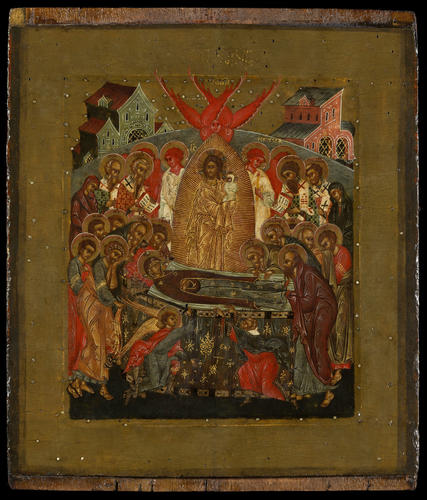The Dormition of the Virgin c.1700
Panel | 31.9 x 27.0 cm (support, canvas/panel/stretcher external) | RCIN 403491
-
This painting is a type of devotional image known as an icon, acting as a window through which the viewer can interact with the holy subjects within. In a similar format to other works of its kind, this particular panel depicts the death of the Virgin, an episode known as the Dormition of the Virgin, or quite literally the 'falling asleep' of the Mother of God. The Virgin lies upon the bier, mourned by the grieving apostles who peer over her head and feet. They are accompanied by four early Christian writers, recognisable by their haloes and Bishops dress: (left to right) Saint James, Timothy, Hierothesus, and Dionysious the Areopagite. Other faithful mourners attend the scene such as the weeping women at the far edges of the composition.
At the centre of the painting is depicted the moment in which the swaddled soul of the Virgin – shown as a small child – is taken into the arms of Christ, flanked by waiting angels. Christ's robes shine with golden light, which radiates out from him in lines to form an almond shape known as a mandorla. This light-filled area – topped with a red, six-winged seraphim - shows that Christ appears in a glorified state, and exists beyond the earthly life.
In the very foreground, the Archangel Michael raises his sword, preparing to cut off the hands of the fanatical Jew, Athonios (also known as Jephonias), who is daring to try and upset the Virgin's funeral bier. This cautionary, apocryphal detail - which takes place close to the viewer's space - is often included in scenes of the Dormition to emphasise the Virgin's life on earth as an intimate and sacred mystery which should not be profaned.
The Dormition of the Virgin is one of the twelve Great Feasts of the Christian Orthodox Church, receiving special veneration on its particular feast day which falls on 15 August. Although this episode does not appear in the Bible, the story of the Virgin's death became important in explaining the mortality of Christ, becoming an established scene in icons particularly from the eleventh century. The Virgin's death proved to believers that Christ – although the Son of God – was born of a mortal mother.
Before passing to Prince Albert, this panel was formerly in the possession of his relative, the German collector Prince Ludwig Kraft Ernst von Oettingen-Wallerstein. In a catalogue compiled while the Oettingen-Wallerstein collection was on display at Kensington Palace, dated 1848, it was alleged that this particular painting was brought by a Crusader, Count Helfenstein, from the East, and had been formerly preserved in the treasury of a sovereign German Abbey.
The many nail holes present in this panel are remnants from the fixing of an earlier frame, likely very elaborate, to surround the painting, as well as from areas of silver once nailed to the haloes of Christ and the Virgin, and in the upper background, leaving only the painted sections containing the figures and buildings visible.
Provenance
One of the group of Russian icons from the 77 paintings belonging to Prince Ludwig von Oettingen-Wallerstein (1791-1870); these were first offered to Prince Albert in 1847 as security for a loan and came into his possession by default (no 1 in Waagen’s catalogue of 1854); 25 of them were accepted by the National Gallery in 1863.
-
Creator(s)
(artist)(artist)Acquirer(s)
-
Medium and techniques
Panel
Measurements
31.9 x 27.0 cm (support, canvas/panel/stretcher external)
61.0 x 35.7 cm (frame, external)
Category
Object type(s)
Alternative title(s)
The Death of the Virgin Mary









